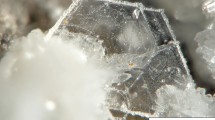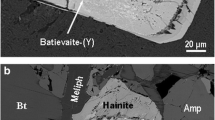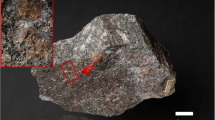Abstract
The new mineral sardignaite, a bismuth molybdate with formula BiMo2O7(OH)·2H2O, occurs in quartz veins within a granitic rock at Su Senargiu, near Sarroch, Sardegna, Italy. The name is after the locality. Sardignaite occurs a thin prismatic crystals up to 1 mm in length, with pale yellow color and a white streak. It is transparent with adamantine lustre, non fluorescent, and brittle with a conchoidal fracture. It is associated with bismuthinite, bismoclite, molybdenite, ferrimolybdite, koechlinite, wulfenite, and the new mineral IMA 2009–022. Mohs hardness is ca. 3. D calc is 4.82 g/cm3. The mineral is monoclinic, space group P21/m, with a 5.7797(7), b 11.567(1), c 6.3344(8) Å, β 113.360(9)°, V 388.8(1) Å3. The strongest lines in the powder X-ray diffraction pattern are d(I)(hkl): 3.206(100)(031), 5.03(80)(−101), 1.992(45)(221), 3.120(32)(130). The crystal structure of sardignaite was solved to R(F) 0.056 using single-crystal X-ray diffraction data, and is characterized by edge-sharing dimers of [MoO5(H2O)] octahedra, linked to each other through corner-sharing to give rise to corrugated columns running along b. Such columns are held together by Bi3+ cations, eight-fold coordinated by 7 O + 1 (OH). Both the mineral and its name were approved by the IMA-CNMNC.
Similar content being viewed by others
Avoid common mistakes on your manuscript.
Introduction
In this paper, the new bismuth molybdate mineral sardignaite is described. The new mineral and its name have been approved by the IMA Commission on New Minerals, Nomenclature and Classification (IMA No. 2008–040). The name sardignaite is after Sardigna (in Italian Sardegna, in English Sardinia), the region in which the mineral was found, as spelt in the local language, which is considered an independent Romance language, and not merely a variety (dialect) of Italian. The mineral collector who found the new mineral (Marzio Mamberti) is a native Sardinian and is very proud of its cultural roots. Sardinia is the fourth Italian region (after Piedmont, Tuscany and Latium) to have a mineral named after it. The holotype of sardignaite is deposited in the mineralogical collection of the “Museo di Storia Naturale e del Territorio” of the University of Pisa, under the catalogue No. 19350.
Geological outline
The presence of molybdenum mineralizations in Sardinia is known since the XIX Century (Jervis 1881). Later on, the exploitation of Sardinian ore deposits resulted in a number of notes on molybdenum mineralizations (Dessau 1956; Venerandi 1968). One of them was specifically devoted to Su Senargiu, the type locality of sardignaite (Caboi et al. 1978).
All the above studies agree in relating the molybdenum mineralizations of Sardinia to leucogranitic intrusions of Hercynic age (Ghezzo et al. 1981), formed by acid intrusive bodies characterized by a fairly homogeneous composition. Quartz is the most abundant mineral and K-feldspar prevails over plagioclase (An2–20). The only femic mineral is biotite, and accessory minerals (apatite, allanite, monazite, zircon) are rare.
The original paragenesis seems to have been affected by alteration phenomena, marked by the pronounced instability of biotite and plagioclase, transformed into sericitic products, chlorite and clay minerals. The only molybdenum-bearing mineral in the above mineralizations is molybdenite, associated with pyrite and minor wolframite, sphalerite, and scheelite. In some intrusions molybdenite occurs as lamellar crystals disseminated in the hosting rock; in other ones, as in the case of the mineralization of Su Senargiu, molybdenite is only found within quartz veins.
At this last locality, in the easternmost part of Sulcis, the mineralization is located at 260 m asl, on the slope of the Su Senargiu mount, in the proximity of the village of Sarroch, and not far from the town of Cagliari.
Molybdenite occurs within quartz veins with thickness ranging from 5 to 15 cm and also, more rarely, within the granitic rock itself (Caboi et al. 1978). The study of several samples, collected in the small dumps in front of the three galleries worked from 1934 to 1953, allowed an accurate definition of the mineralogical association at Su Senargiu: besides molybdenite, native bismuth, bismuthinite, pyrite, sphalerite, cassiterite, anatase, brookite, aeschynite-(Ce), bismoclite, ferrimolybdite, koechlinite, wulfenite, muscovite, and synchysite-(Ce) were observed.
Occurrence and physical properties
The new mineral sardignaite occurs within cavities of quartz veins in granitic rock at Su Senargiu, Sarroch, (CA), Sardinia, Italy. Associated minerals are bismuthinite, bismoclite, molybdenite, ferrimolybdite, koechlinite, wulfenite, and the new mineral IMA 2009–022. Sardignaite is a secondary mineral formed in the oxidation zone of a molybdenite-bismuthinite deposit.
At the type locality, sardignaite occurs as prismatic and very thin elongated [010] and tabular {100} crystals up to 1 mm in length and a few microns in diameter (Fig. 1). Bundles of crystals with parallel elongation are also common. Crystals are pale yellow with a white streak, transparent with adamantine lustre, non fluorescent, and brittle with a conchoidal fracture. Mohs hardness is ca. 3. Density was not measured because its value was too high to be reached with heavy liquids and there was not enough material for weighting methods. The calculated density is 4.82 g/cm3. The sign of the optical elongation is positive on [010]. Birefrincence is high. The mean refractive index, obtained from Gladstone-Dale equilibrium using chemical composition and calculated density, is 2.04.
Chemical data
Chemical analyses of sardignaite were performed with an ARL-SEMQ electron microprobe. Operating conditions were: WDS mode, 15 kV, 20 nA, beam diameter 6 μm. According to preliminary SEM-EDS analyses, which revealed the presence of Pb, Bi, Mo, and W, only those elements were probed. No S was observed during EPMA, which could have been overlooked due to overlap with lines of Pb and Bi in the SEM-EDS. Analytical data and probe standards are given in Table 1. H2O and CO2 were not determined directly. H2Ocalc was included in the chemical analysis according to the chemical formula resulting from the single-crystal X-ray diffraction study, which also confirmed that neither CO2 nor other light elements occur. The high analytical total (101.89 wt.%) is likely to result from minor dehydration under the electron beam. The empirical formula of sardignaite, based on 10 oxygen atoms, is: Bi0.980Pb0.010Mo2.007O7(OH)1.000·2H2O. The simplified formula is BiMo2O7(OH)·2H2O.
X-ray diffraction study
The X-ray powder diffraction pattern of sardignaite was collected with a 114.6 mm diameter Gandolfi camera, using CuKα radiation, and is reported in Table 2. The unit-cell parameters, refined from 27 unequivocally indexed reflections, are: a = 5.793(3), b = 11.540(5), c = 6.341(4) Å, β = 113.28(3)°, V = 389.4(3) Å3. These values are in fair agreement with those determined from the single-crystal study (see below).
The single-crystal X-ray diffraction study was started with the collection of rotation and Weissenberg photographs, which indicated monoclinic symmetry, and systematic absences pointing to either P21 or P21/m as possible space groups.
Then a selected, relatively thick single crystal (dimensions ca. 0.18 × 0.12 × 0.30 mm) was mounted on a conventional Siemens P-4 four-circle diffractometer equipped with a X-ray tube using graphite-monochromated MoKα radiation (λ = 0.71069 Å). The following unit-cell parameters were refined through least-squares fit of 2θ values of 46 accurately centered reflection (24° < 2θ < 36°): a = 5.7797(7), b = 11.567(1), c = 6.3344(8), β = 113.360(9)°, V = 388.8(1) Å3. The intensity data collection was carried out in θ–2θ scan mode up to 2θmax = 70°, with scan width (in θ) ±0.50°, and scan speed 2°/min. The 2,372 measured intensities were reduced to a set of 1,785 independent squared structure amplitudes after correction for Lorentz, polarisation and absorption, the latter based on a set of ψ-scan measurements.
The crystal structure of sardignaite was solved with direct methods in the space group P21/m. At first the positions of Bi and Mo were found, and then six out of the most relevant residual electron density maxima were interpreted as oxygen atoms and selected so as to model reasonable coordination polyhedra around the cations. The nature of coordinating anions (whether oxygens, hydroxyls, or water molecules) was assessed on the basis of the bond-valence sums. Any attempt to locate the hydrogen atoms was unsuccessful. The full matrix refinement of the structural model, with anisotropic displacement parameters for all atoms, converged to R1 (conventional R(F) factor) = 0.056 for 1,651 non-zero [F o > 4σ(F o)] reflections, wR2 (weighted R on F 2) = 0.1491, S (goodness of fit) = 1.131. A total of 65 parameters were refined. The maximum and minimum peaks in the final difference-Fourier map were +9.19 and −3.37 e/Å3, respectively. All highest peaks are in the close surroundings of the cation sites, and are likely to be the result of minor inaccuracies in the absorption surface modeling which may have caused small distortions of the thermal ellipsoids. Structure solution and refinement were carried out with the SHELX-97 package of programs (Sheldrick 2008), implemented within the WinGX program system (Farrugia 1999). Final positional and displacement parameters are given in Table 3; bond distances are given in Table 4, and a bond-valence analysis in Table 5.
Description of the structure
The crystal structure of sardignaite is shown in Fig. 2. The structure is characterized by edge-sharing dimers of [MoO5(H2O)] octahedra. Dimers in turn link each other through corner-sharing to give rise to corrugated columns running along b. Columns are held together by Bi3+ cations, eight-fold coordinated by 7 O + 1 (OH). The cross-linking of columns by Bi3+ is not evenly distributed, being stronger along [100] and weaker along [−101]. Along this latter direction, columns are held together only by the weak, 3.05 Å long Bi-O1 bonds and by the system of hydrogen bonds (Fig. 3).
The Bi-centered coordination polyhedron may be roughly described as an augmented pentagonal bipyramid. The cation lies more or less at the centre of the pentagonal basis of the bipyramid, which is terminated on one side by a strongly bonded O5 (OH), and on the other side by a pair of weakly bonded O1 (Fig. 4a).
The Mo-centered coordination polyhedron has six ligands in the range 1.711–2.353 Å. The longest bond distance is to O6 (H2O). The six ligands define a fairly regular octahedron, with the central cation displaced off the central position (Fig. 4b).
Although hydrogen atoms could not be located, a plausible hydrogen-bonding scheme can be suggested on the basis of the O ... O interactions between oxygens not belonging to the same coordination polyhedron (Table 4) and of the bond-valence analysis (Table 5).
O5, which belongs to a hydroxyl group, has two contacts with two equivalent O6 atoms (water molecules), above and below the mirror on which O5 lies. O6 has two contacts with another O6 and with O1.
In the proposed hydrogen-bonding scheme, O5 (OH) could be donor of a hydrogen bond toward either of the two O6, and the other O6 (H2O) could be donor of two hydrogen bonds towards O5 and O1, with an O1 - O6 - O5 angle of 90°. This scheme is, however, not consistent with the P21/m symmetry, which should reduce to P21.
In an alternative scheme, O5 (OH) could be donor of two statistically distributed hydrogen bonds (or a so-called bifurcated hydrogen bond) toward the two equivalent O6 atoms, whereas O6 (H2O) could be donor of two hydrogen bonds toward a symmetry-equivalent O6 and toward O1, with an O1 - O6 - O6 angle of 132°.
A third scheme could be possible, which would involve O5 and O6 only, and no hydrogen bonds reaching O1.
Since the actual positions of the hydrogen atoms could not be located, all the above schemes seem plausible. The first one, however, is preferable since it improves the charge balance for O1, which shows some undersaturation, as well as for O5 and O6 (see Table 5).
A synthetic analogue of sardignaite is known (Hriljac and Torardi 1993). We did not use it as a starting model for our structure analysis, since we were not aware yet of it when we solved the structure of sardignaite. Consequently, different axial setting and asymmetric unit were chosen. If we compare the two structural models, after the necessary changes, the unit cell parameters, the atomic coordinates, and the bond lenghts are in good agreement.
Related species
Among all known mineral species, those having molybdenum as an essential component are less than forty. Out of these, there are only three which also have bismuth as an essential component: koechlinite, (BiO2)MoO4 (Schaller 1916); chiluite, Bi6Mo2Te2O21 (Yang et al. 1989); and schlegelite, Bi7O4(MoO4)2(AsO4)3 (Krause et al. 2006).
Of the three previously known bismuth molybdate minerals, koechlinite is chemically closer to sardignaite, having only bismuth and molybdenum as major cations. Its crystal structure, however, has no relationship with that of sardignaite (Van den Elzen and Rieck 1973; Teller et al. 1984). Schlegelite is a bismuth molybdate-arsenate, whose crystal structure is described in detail (Krause et al. 2006). Chiluite was reported to be a bismuth molybdate-tellurate (Yang et al. 1989). However, chiluite is a mineral that needs further study: a synthetic compound with the same chemical formula as that of chiluite has been described (Deng and Yang 1993), whose unit-cell parameters do not match those of the mineral.
As a matter of fact, beyond being a simple bismuth molybdate, sardignaite displays an unprecedented structure topology among minerals, and has no evident crystal-chemical relations with known species.
More recently, another bismuth molybdate with ideal chemical formula BiMo2O7(OH)·H2O was found at the same locality and approved as a new mineral (IMA No. 2009–022). It will be described in detail elsewhere.
References
Brese NE, O’Keeffe M (1991) Bond-valence parameters for solids. Acta Crystallogr B47:192–197
Caboi R, Massoli-Novelli R, Sanna G (1978) La mineralizzazione a molibdenite di P.ta Senargiu. Rend Soc Ital Mineral Petrol 34:167–186
Deng M, Yang X (1993) Bi6Te2Mo2O21—a new synthetic crystal and its physical properties. J Cryst Growth 128:876–879
Dessau G (1956) Cenni sul giacimento di tungsteno e molibdeno di Perda majori. Boll Soc Geol Ital 75:239–250
Farrugia LJ (1999) WinGX suite for single-crystal small-molecule crystallography. J Appl Crystallogr 32:837–838
Ferraris G, Ivaldi G (1988) Bond valence vs. bond length in O···O hydrogen bonds. Acta Crystallogr B44:341–344
Ghezzo C, Guasparri G, Riccobono F, Sabatini G, Pretti S, Uras I (1981) Le mineralizzazioni a molibdeno associate al magmatismo intrusivo ercinico della Sardegna. Rend Soc Ital Mineral Petrol 38:133–145
Hriljac JA, Torardi CC (1993) Synthesis and structure of the novel layered oxide BiMo2O7(OH)·2H2O. Inorg Chem 32:6003–6007
Jervis G (1881) I tesori sotterranei d’Italia. Parte terza: Regione delle isole Sardegna e Sicilia e addenda ai precedenti volumi. Loescher, Torino, p 539
Krause K, Bernhardt HJ, Effenberger H (2006) Schlegelite, Bi7O4(MoO4)2(AsO4)3, a new mineral from Schneeberg, Saxony, Germany. Eur J Mineral 18:803–811
Schaller WT (1916) Koechlinite (bismuth molybdate), a new mineral. US Geol Surv Bull 610:10–34
Sheldrick GM (2008) A short history of SHELX. Acta Crystallogr A64:112–122
Teller RG, Bradzil JF, Grasselli RK, Jorgensen JD (1984) The structure of γ-bismuth molybdate, Bi2MoO6, by powder neutron diffraction. Acta Crystallogr C40:2001–2005
Van den Elzen AF, Rieck GD (1973) Redetermination of the structure of Bi2MoO6, koechlinite. Acta Crystallogr B29:2436–2438
Venerandi I (1968) Il giacimento a molibdenite e wolframite di Perda Majori. Ist Lombardo (Rend Sci) A102:678–716
Yang X, Li D, Wang G, Deng M, Chen N, Wang S (1989) A study of chiluite—A new mineral found in Chilu, Fujian, China. Acta Mineral Sinica 9:9–14
Acknowledgements
We wish to thank Marzio Mamberti, who gave us the first specimen containing sardignaite, and Giuseppe Tanca, Fernando Caboni and Antonello Vinci, who provided us with additional samples used for the complete characterization of the new mineral. A special thank is due in memoriam to the late Mario Gelosa (1947–2006), a mineral collector and friend who first drew our attention to the study of the minerals of the Su Senargiu mine. The paper was reviewed carefully by Uwe Kolitsch and an anonymous referee.
Author information
Authors and Affiliations
Corresponding author
Additional information
Editorial handling: L. Nasdala
Rights and permissions
About this article
Cite this article
Orlandi, P., Pasero, M. & Bigi, S. Sardignaite, a new mineral, the second known bismuth molybdate: description and crystal structure. Miner Petrol 100, 17–22 (2010). https://doi.org/10.1007/s00710-010-0111-0
Received:
Accepted:
Published:
Issue Date:
DOI: https://doi.org/10.1007/s00710-010-0111-0








